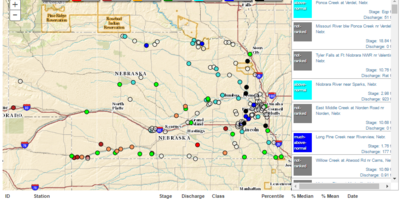Due to a lapse in appropriations, the majority of USGS websites may not be up to date and may not reflect current conditions. Websites displaying real-time data, such as Earthquake and Water and information needed for public health and safety will be updated with limited support. Additionally, USGS will not be able to respond to inquiries until appropriations are enacted. For more information, please see www.doi.gov/shutdown
Nebraska Water Science Center
Home
Welcome to the USGS Nebraska Water Science Center (NEWSC) web site. The NEWSC collects high-quality hydrologic data and conducts unbiased, scientifically sound research on Nebraska's water resources. We strive to provide relevant hydrologic data and meet the changing needs of partners.
Current Water Conditions

See real-time Nebraska streamflow, groundwater, and water-quality conditions and historical data from our water dashboard.
View the dashboardScience Highlights

Leading, innovating, and excelling in hydrologic monitoring, investigations, research, and data delivery for Nebraska.
Find out howQuick Links
See some of our most popular links.
Missouri River Water Information Portal
Check out our dataNews
Reservoir Sediment Can be Used as Fracking Proppant
Instead of requiring costly dredging to remove sediment buildup behind water reservoirs and diversions, sediment from reservoirs in the Missouri River Basin could actually be used as fracking proppant feedstock, also known as frac sand, according to a recently published U.S. Geological Survey study.
EarthWord–Zoonotic
Sharing isn’t always polite, judging by this EarthWord.
High Flows in North-Central and Northeast Nebraska
Recent storms in north-central and northeast Nebraska have caused high flows in several rivers, streams and creeks.
Publications
Relating cyanobacteria and physicochemical water-quality properties in Willow Creek Lake, Nebraska, 2012–14
Cyanobacteria (also referred to as blue-green algae) are naturally present members of phytoplankton assemblages that may detract from beneficial uses of water because some strains produce cyanotoxins that pose health hazards to people and animals. Cyanobacteria populations observed in Willow Creek Lake during 2012 through 2014 were compared to...
Rus, David L.; Hall, Brent M.; Thomas, Steven A.Simulation of groundwater flow, 1895–2010, and effects of additional groundwater withdrawals on future stream base flow in the Elkhorn and Loup River Basins, central Nebraska—Phase three
The U.S. Geological Survey, in cooperation with the Lewis and Clark, Lower Elkhorn, Lower Loup, Lower Platte North, Lower Niobrara, Middle Niobrara, Upper Elkhorn, and the Upper Loup Natural Resources Districts, designed a study to refine the spatial and temporal discretization of a previously modeled area. This updated study focused on a 30,...
Flynn, Amanda T.; Stanton, Jennifer S.Groundwater discharge characteristics for selected streams within the Loup River Basin, Nebraska, 2014–16
Streams in the Loup River Basin are sensitive to groundwater withdrawals because of the close hydrologic connection between groundwater and surface water. Groundwater discharge is the primary component of streamflow in the Loup River Basin and constitutes more than 90 percent of streamflow in the central part of the Sand Hills. To improve the...
Hobza, Christopher M.; Schepers, Aaron R.






